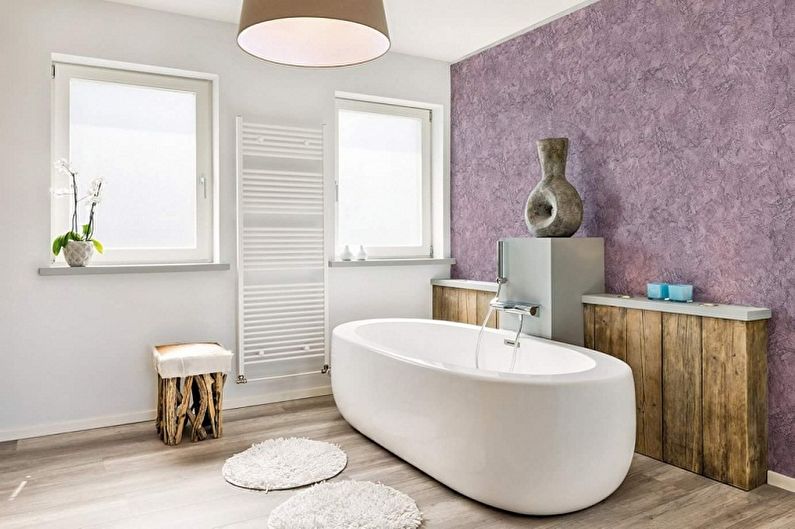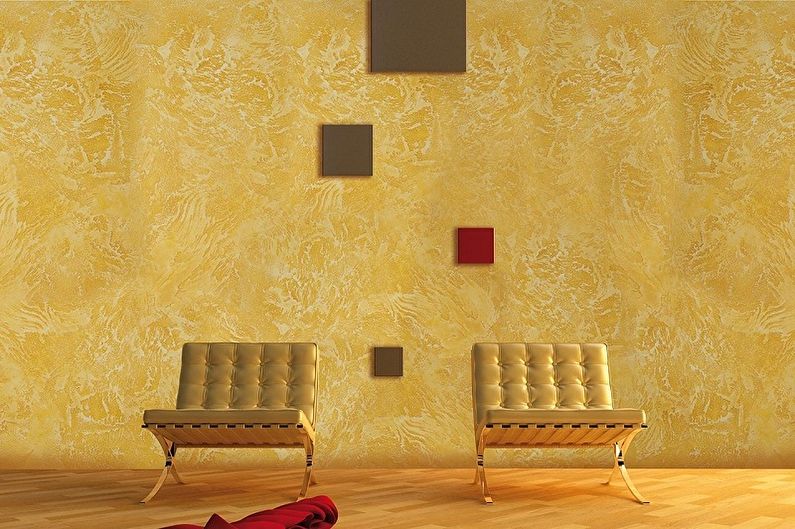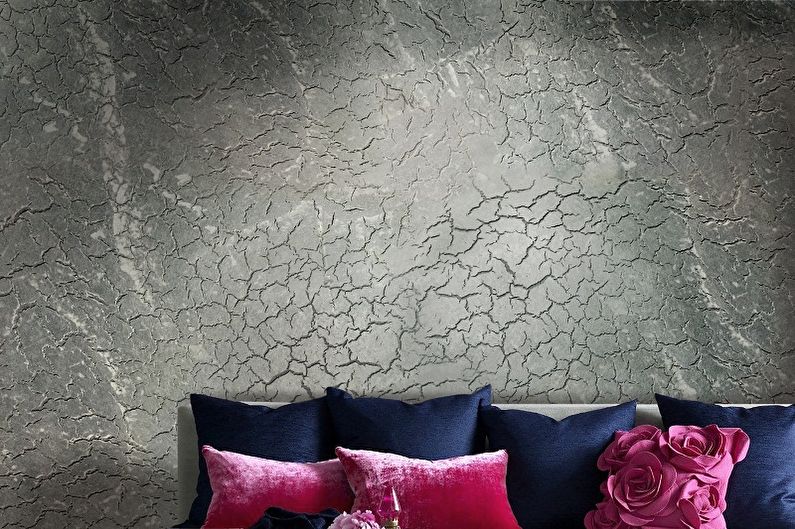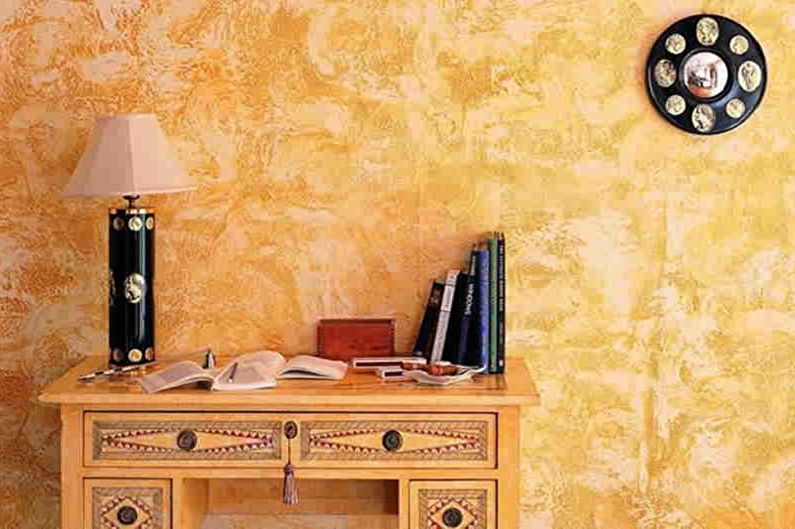
One of the new, yet already quite popular options for wall decoration is decorative textured paint. Unlike its predecessors, which gave the walls a standard smooth look, textured paint can create unique volumetric patterns. The peculiarity lies in the originality of the finish – after all, each master applies the canvas with individual strokes, which are quite difficult to repeat. Next, we will look at what types of textured paints there are and how to work with them.
Features of Textured Paint
The main feature of all textured paints, which distinguishes them from ordinary ones, is their volume. The reliefs of the patterns allow the creation of beautiful wall canvases with an individual approach to decoration and help hide any imperfections in room dividers. Textured mass looks like a semi-transparent substance and surprises with its considerable strength, preserving the surfaces of the walls. Textured paints are characterized by high resistance to various influences (temperature changes, high humidity, ultraviolet), so they can be confidently used in the decoration of interior and exterior cladding, which will last for many years.
The composition includes an acrylic base, which is supplemented with various additives that help in creating a relief canvas. It is easy to get any desired shade by adding the necessary colorant. The advantage of this type of finish is the simplicity of application. Anyone, even the most far from construction work home handyman, can work with paints. Some even manage to prepare the mixture on their own at home.
Another important point is that textured paints are made from environmentally safe materials, do not provoke allergic reactions, so they can be safely used in any room, including children’s.


What types of fillers are used
Structural mixtures, as we have already mentioned, have fillers of different types, which have individual characteristics. To date, manufacturing companies offer four main types of fillers, namely:
– Acrylic – the filler provides resistance to most external influences;
– Silicone – implies the presence of the same name resins, which provide a high level of practicality;
– Mineral – the basis are cement and lime. Paints with such a composition will be perfect for outdoor work;
– Silicate – paints with such a filler are considered the most expensive material. It includes liquid glass, which forms a protective surface layer, thanks to which compositions are suitable for exterior decoration. Also, the composition of textured paint can include granite crumb, metallic dust with reflective properties, pigments that give a special pearl or silk shade.
The composition can be made independently at home. In this case, the main fillers of regular acrylic paint will be granite crumbs, sawdust, or quartz sand (neither sea nor ordinary will do). The risk of such manufacture of textured paint is that it is difficult to predict the final result – it may eventually differ greatly from the desired one. Therefore, if you still decide to make such a composition – start with a small amount, decorate a hidden part of the wall with it. If the appearance of the finish pleases – you can start making a large portion.

Types of Textured Paint
Textured paint has its own variations, which allows you to choose the most suitable composition for creating this or that striking pattern. The most popular are:
1. Atacama. The paint contains metal chips and quartz sand in equal proportions. The composition allows you to achieve the volume of the canvas, which will be endowed with a velvety base.
2. Missouri. The basis contains modified starch, which allows the creation of smooth and textured surfaces.
3. Marseilles wax. It will be perfect for any room. The paint is additionally covered with wax and has protection from moisture and evaporation.
4. Relief. It has a whole range of fillers, thanks to which you can easily create various reliefs with a smooth spatula.


How to Work with Textured Paint
Working with textured paint does not pose any particular difficulties – the whole process can be divided into several stages. Before starting, you should give the paint the desired shade, using special liquid concentrated dyes. Then we prepare the tool.
The main layer of paint is applied with a spatula, and there are many options for creating a relief. A good helper in work will be a figured roller, the surface of which has convex patterns that are printed on the primary layer. A regular roller with a fur (foam) nozzle, giving the surface roughness, will also do.
You can apply a deep rare relief on the surface with a stiff brush, drawing wavy, straight lines in a strict or chaotic order. Even a simple sponge or crumpled paper can become a wonderful tool for creativity – they make stamping movements, giving the surface a peculiar ripple. If you are already armed with everything you need – we get to work.
Stage 1
The first thing to do is to put the walls in order, remove the previous coating completely. If they have significant curvature, serious damage with falling off pieces – these problems need to be eliminated, and minor chips and scratches will be masked by a thick layer of relief paint.

Stage 2
We apply a base layer of paint to the prepared walls using a metal or wooden spatula. Its thickness should not exceed 1.5 cm. It should be noted that some compounds are not recommended to be installed at extremely high or low temperatures – the manufacturer must warn about this.

Stage 3
The most responsible process is the creation of relief. Remember that the paint dries in about fifteen minutes, so the work needs to be done quite quickly or with a partner (one applies the paint, and the other follows with a pattern). We have already considered what tools to choose to create the desired pattern of the canvas. We’ll just add that to enhance the effect of balancing the color palette, you can wax or varnish the finished surface, but only after 48 hours for the canvas to dry completely.


Textured Paints for Walls – Photo
In conclusion, we invite you to visit our photo gallery. Here are collected the best examples of decoration and finishing of walls with textured paints. Enjoy your viewing!






























Leave feedback about this